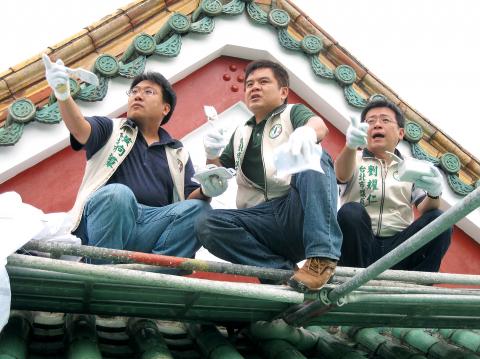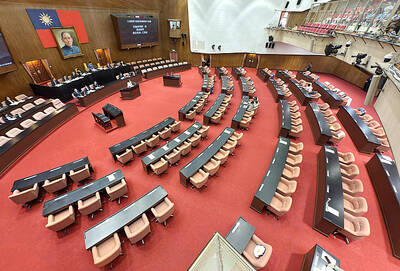Three Taipei City Councilors from the Democratic Progressive Party (DPP) have been found not guilty by the Taipei District Court for climbing onto Taipei’s Jingfu Gate (景福門) and covering the Chinese Nationalist Party (KMT) emblem with white paint in May last year.
In a ruling handed down on Thursday, Taipei District Court Judge Lin Meng-huang (林孟皇) said the emblem that Taipei City councilors Chuang Ruei-hsiung (莊瑞雄), Huang Hsiang-chun (黃向群) and Liu Yao-ren (劉耀仁) covered with paint was a political insignia that represented the way Taiwan used to be a dictatorship under party-state rule.
By covering the emblem with white paint, the three were expressing their dissatisfaction and were not guilty of destroying a historical monument.

Photo: CNA
When the incident first happened, then-commissioner of the Taipei City Government’s Department of Cultural Affairs Lee Yong-ping (李永萍) said that the Jingfu Gate was a nationally designated historical monument and that the councilors knew they were taking the law into their own hands by painting it.
Prosecutors in the case believed the actions of the city councilors destroyed a cultural relic therefore they were guilty of destroying a historical monument and this is why they prosecuted them.
Judge Lin said that although the party emblem is protected by the Culture Heritage Preservation Act (文化資產保存法), he believes the three were not guilty of destroying a historical monument.
The court verdict stated that there are two types of emblems on Jingfu Gate and that they only really differ in size, with one being a national emblem and the other a party emblem, and that the similarity between the two easily leads to disputes over the separation of party and state.
Lin said the party emblem was put on the gate — originally built during the Qing Dynasty — in 1966 when it was repaired and that this was a remnant of the authoritarian rule Taiwan was under at that time. Lin added that the emblem was a way in which the KMT had tried to consolidate its legitimacy and power and that the emblem was therefore an ideological expression and a political insignia put on a historical monument.
The city councilors said that on May 26 last year, when they saw the KMT party emblem on the gate, they felt that they had a responsibility to monitor the maintenance of historical monuments by the Taipei City Government.
The trio said that only three days after the celebration of President Ma Ying-jeou’s (馬英九) first year in office, the Jingfu Gate had a new party emblem put on it and that it was insulting to Taiwan’s citizens as such a move was taken to please certain groups and individuals.
They said they merely climbed up and painted over the emblem in white paint and that to this day, the Taipei City government has not returned the emblem to its original blue color, so they were not guilty of destroying an ancient relic.
Lin said he believes the three councilors covered the emblem in white paint as a way of protesting the China-centric ideology that the KMT party emblem represents and that their actions were a political call.
Lin also mentioned “transitional justice” in the court verdict. Lin said that in 2004, the Culture Heritage Preservation Act was amended with a focus on the promotion of a more diversified culture instead of a Chinese-centric culture.
Lin said that in order to realize transitional justice, this principle was kept in mind when dealing with the case and that the three -councilors were therefore not found guilty of destroying the historical and cultural value of the gate.
Commenting on the verdict, Chuang and the others said they did not expect to be found guilty.
“It is wrong for a democratic government to paint a political party’s emblem on an ancient relic three days after the celebration of their first year in office,” Chuang said.
Saying they were only -responsible for covering one -emblem with white paint and that the other emblems that were covered up were covered up by members of the KMT, Chuang added that if they had been found guilty, then the KMT should also be guilty.
Taipei City Government spokesperson Chao Hsin-ping (趙心屏) said the Taipei City Government would respect prosecutors’ decision as to whether the case would be appealed.

CROSS-STRAIT COLLABORATION: The new KMT chairwoman expressed interest in meeting the Chinese president from the start, but she’ll have to pay to get in Beijing allegedly agreed to let Chinese Nationalist Party (KMT) Chairwoman Cheng Li-wun (鄭麗文) meet with Chinese President Xi Jinping (習近平) around the Lunar New Year holiday next year on three conditions, including that the KMT block Taiwan’s arms purchases, a source said yesterday. Cheng has expressed interest in meeting Xi since she won the KMT’s chairmanship election in October. A source, speaking on condition of anonymity, said a consensus on a meeting was allegedly reached after two KMT vice chairmen visited China’s Taiwan Affairs Office Director Song Tao (宋濤) in China last month. Beijing allegedly gave the KMT three conditions it had to

‘BALANCE OF POWER’: Hegseth said that the US did not want to ‘strangle’ China, but to ensure that none of Washington’s allies would be vulnerable to military aggression Washington has no intention of changing the “status quo” in the Taiwan Strait, US Secretary of Defense Pete Hegseth said on Saturday, adding that one of the US military’s main priorities is to deter China “through strength, not through confrontation.” Speaking at the annual Reagan National Defense Forum in Simi Valley, California, Hegseth outlined the US Department of Defense’s priorities under US President Donald Trump. “First, defending the US homeland and our hemisphere. Second, deterring China through strength, not confrontation. Third, increased burden sharing for us, allies and partners. And fourth, supercharging the US defense industrial base,” he said. US-China relations under

The Chien Feng IV (勁蜂, Mighty Hornet) loitering munition is on track to enter flight tests next month in connection with potential adoption by Taiwanese and US armed forces, a government source said yesterday. The kamikaze drone, which boasts a range of 1,000km, debuted at the Taipei Aerospace and Defense Technology Exhibition in September, the official said on condition of anonymity. The Chungshan Institute of Science and Technology and US-based Kratos Defense jointly developed the platform by leveraging the engine and airframe of the latter’s MQM-178 Firejet target drone, they said. The uncrewed aerial vehicle is designed to utilize an artificial intelligence computer

The Chinese Nationalist Party (KMT) caucus yesterday decided to shelve proposed legislation that would give elected officials full control over their stipends, saying it would wait for a consensus to be reached before acting. KMT Legislator Chen Yu-jen (陳玉珍) last week proposed amendments to the Organic Act of the Legislative Yuan (立法院組織法) and the Regulations on Allowances for Elected Representatives and Subsidies for Village Chiefs (地方民意代表費用支給及村里長事務補助費補助條例), which would give legislators and councilors the freedom to use their allowances without providing invoices for reimbursement. The proposal immediately drew criticism, amid reports that several legislators face possible charges of embezzling fees intended to pay